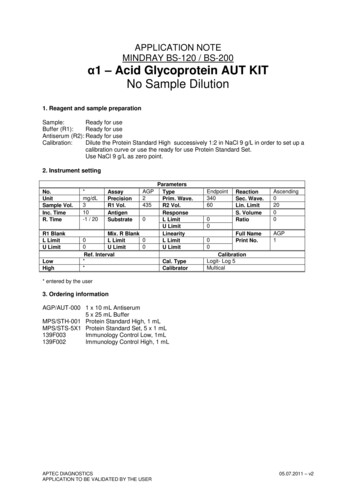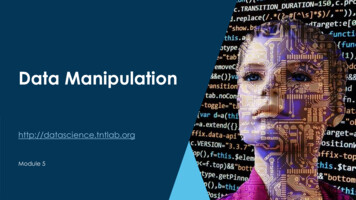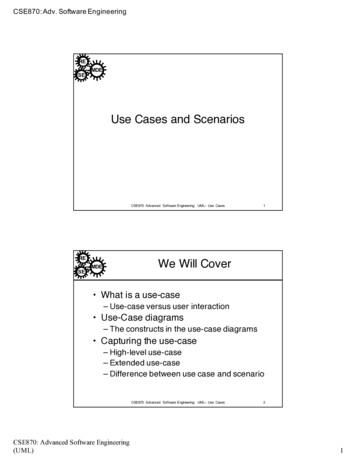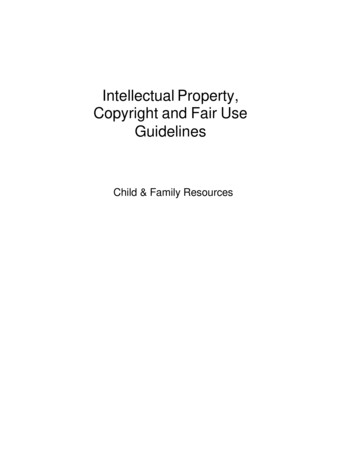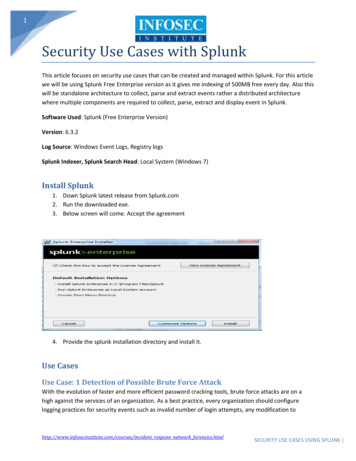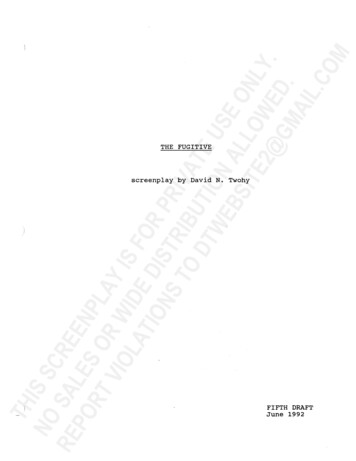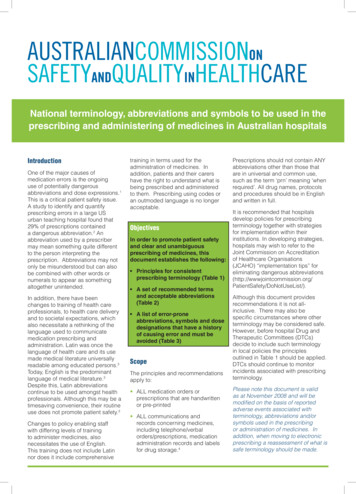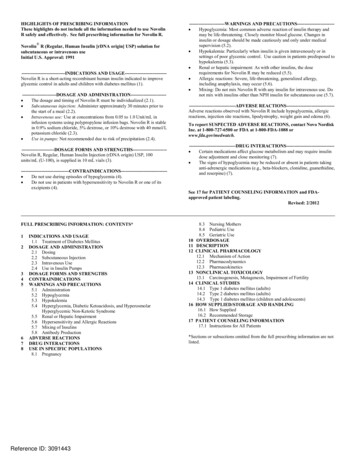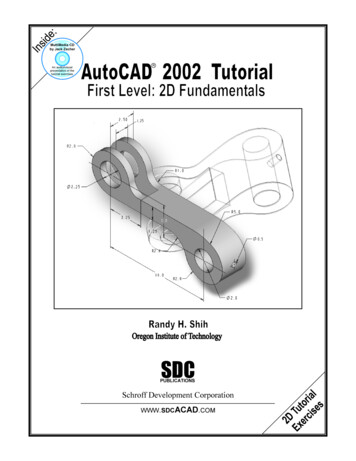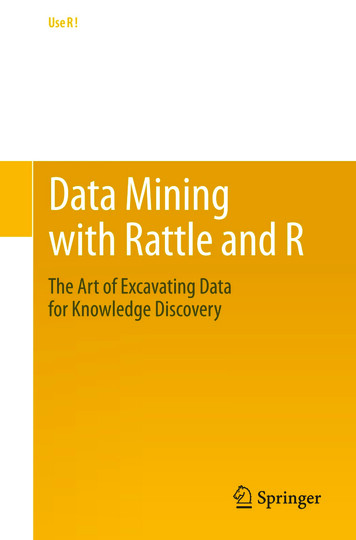
Transcription
Use R!Series Editors:Robert Gentleman Kurt Hornik Giovanni G. ParmigianiFor further volumes:http://www.springer.com/series/6991
Graham WilliamsData Mining with Rattleand RThe Art of Excavating Data for KnowledgeDiscovery
Graham WilliamsTogaware Pty LtdPO Box 655Jamison CentreACT, 2614AustraliaGraham.Williams@togaware.comSeries Editors:Robert GentlemanProgram in Computational BiologyDivision of Public Health SciencesFred Hutchinson Cancer Research Center1100 Fairview Avenue, N. M2-B876Seattle, Washington 98109USAKurt HornikDepartment of Statistik and MathematikWirtschaftsuniversität WienAugasse 2-6A-1090 WienAustriaGiovanni G. ParmigianiThe Sidney Kimmel ComprehensiveCancer Center at Johns Hopkins University550 North BroadwayBaltimore, MD 21205-2011USAISBN 978-1-4419-9889-7e-ISBN 978-1-4419-9890-3DOI 10.1007/978-1-4419-9890-3Springer New York Dordrecht Heidelberg LondonLibrary of Congress Control Number: 2011934490 Springer Science Business Media, LLC 2011All rights reserved. This work may not be translated or copied in whole or in part without the writtenpermission of the publisher (Springer Science Business Media, LLC, 233 Spring Street, New York,NY 10013, USA), except for brief excerpts in connection with reviews or scholarly analysis. Use inconnection with any form of information storage and retrieval, electronic adaptation, computer software,or by similar or dissimilar methodology now known or hereafter developed is forbidden.The use in this publication of trade names, trademarks, service marks, and similar terms, even if they arenot identified as such, is not to be taken as an expression of opinion as to whether or not they are subjectto proprietary rights.Printed on acid-free paperSpringer is part of Springer Science Business Media (www.springer.com)
To Catharina
PrefaceKnowledge leads to wisdom and better understanding. Data miningbuilds knowledge from information, adding value to the ever-increasingstores of electronic data that abound today. Emerging from the databasecommunity in the late 1980s’ data mining grew quickly to encompassresearchers and technologies from machine learning, high-performancecomputing, visualisation, and statistics, recognising the growing opportunity to add value to data. Today, this multidisciplinary and transdisciplinary effort continues to deliver new techniques and tools for the analysis of very large collections of data. Working on databases that are nowmeasured in the terabytes and petabytes, data mining delivers discoveries that can improve the way an organisation does business. Data mining enables companies to remain competitive in this modern, data-rich,information-poor, knowledge-hungry, and wisdom-scarce world. Datamining delivers knowledge to drive the getting of wisdom.A wide range of techniques and algorithms are used in data mining.In performing data mining, many decisions need to be made regardingthe choice of methodology, data, tools, and algorithms.Throughout this book, we will be introduced to the basic conceptsand algorithms of data mining. We use the free and open source softwareRattle (Williams, 2009), built on top of the R statistical software package(R Development Core Team, 2011). As free software the source codeof Rattle and R is available to everyone, without limitation. Everyoneis permitted, and indeed encouraged, to read the source code to learn,understand verify, and extend it. R is supported by a worldwide networkof some of the world’s leading statisticians and implements all of the keyalgorithms for data mining.This book will guide the reader through the various options thatRattle provides and serves to guide the new data miner through the useof Rattle. Many excursions into using R itself are presented, with the aimvii
viiiPrefaceof encouraging readers to use R directly as a scripting language. Throughscripting comes the necessary integrity and repeatability required forprofessional data mining.FeaturesA key feature of this book, which differentiates it from many other verygood textbooks on data mining, is the focus on the hands-on end-to-endprocess for data mining. We cover data understanding, data preparation,model building, model evaluation, data refinement, and practical deployment. Most data mining textbooks have their primary focus on just themodel building—that is, the algorithms for data mining. This book, onthe other hand, shares the focus with data and with model evaluationand deployment.In addition to presenting descriptions of approaches and techniquesfor data mining using modern tools, we provide a very practical resourcewith actual examples using Rattle. Rattle is easy to use and is built on topof R. As mentioned above, we also provide excursions into the commandline, giving numerous examples of direct interaction with R. The readerwill learn to rapidly deliver a data mining project using software obtainedfor free from the Internet. Rattle and R deliver a very sophisticated datamining environment.This book encourages the concept of programming with data, andthis theme relies on some familiarity with the programming of computers. However, students without that background will still benefit from thematerial by staying with the Rattle application. All readers are encouraged, though, to consider becoming familiar with some level of writingcommands to process and analyse data.The book is accessible to many readers and not necessarily just thosewith strong backgrounds in computer science or statistics. At times, wedo introduce more sophisticated statistical, mathematical, and computerscience notation, but generally aim to keep it simple. Sometimes thismeans oversimplifying concepts, but only where it does not lose the intentof the concept and only where it retains its fundamental accuracy.At other times, the presentation will leave the more statistically sophisticated wanting. As important as the material is, it is not alwayseasily covered within the confines of a short book. Other resources coversuch material in more detail. The reader is directed to the extensive
Prefaceixmathematical treatment by Hastie et al. (2009). For a more introductory treatment using R for statistics, see Dalgaard (2008). For a broaderperspective on using R, including a brief introduction to the tools in Rfor data mining, Adler (2010) is recommended. For an introduction todata mining with a case study orientation, see Torgo (2010).OrganisationChapter 1 sets the context for our data mining. It presents an overviewof data mining, the process of data mining, and issues associated withdata mining. It also canvasses open source software for data mining.Chapter 2 then introduces Rattle as a graphical user interface (GUI)developed to simplify data mining projects. This covers the basics ofinteracting with R and Rattle, providing a quick-start guide to data mining.Chapters 3 to 7 deal with data—we discuss the data, exploratory,and transformational steps of the data mining process. We introducedata and how to select variables and the partitioning of our data inChapter 3. Chapter 4 covers the loading of data into Rattle and R.Chapters 5 and 6 then review various approaches to exploring the datain order for us to gain our initial insights about the data. We also learnabout the distribution of the data and how to assess the appropriatenessof any analysis. Often, our exploration of the data will lead us to identifyvarious issues with the data. We thus begin cleaning the data, dealingwith missing data, transforming the data, and reducing the data, as wedescribe in Chapter 7.Chapters 8 to 14 then cover the building of models. This is the nextstep in data mining, where we begin to represent the knowledge discovered. The concepts of modelling are introduced in Chapter 8, introducingdescriptive and predictive data mining. Specific descriptive data miningapproaches are then covered in Chapters 9 (clusters) and 10 (associationrules). Predictive data mining approaches are covered in Chapters 11(decision trees), 12 (random forests), 13 (boosting), and 14 (support vector machines). Not all predictive data mining approaches are included,leaving some of the well-covered topics (including linear regression andneural networks) to other books.Having built a model, we need to consider how to evaluate its performance. This is the topic for Chapter 15. We then consider the task ofdeploying our models in Chapter 16.
xPrefaceAppendix A can be consulted for installing R and Rattle. Both Rand Rattle are open source software and both are freely available onmultiple platforms. Appendix B describes in detail how the datasetsused throughout the book were obtained from their sources and howthey were transformed into the datasets made available through rattle.Production and Typographical ConventionsThis book has been typeset by the author using LATEX and R’s Sweave().All R code segments included in the book are run at the time of typesetting the book, and the results displayed are directly and automaticallyobtained from R itself. The Rattle screen shots are also automaticallygenerated as the book is typeset.Because all R code and screen shots are automatically generated,the output we see in the book should be reproducible by the reader. Allcode is run on a 64 bit deployment of R on a Ubuntu GNU/Linux system.Running the same code on other systems (particularly on 32 bit systems)may result in slight variations in the results of the numeric calculationsperformed by R.Other minor differences will occur with regard to the widths of linesand rounding of numbers. The following options are set when typesettingthe book. We can see that width is set to 58 to limit the line width forpublication. The two options scipen and digits affect how numbersare presented: options(width 58, scipen 5, digits 4, continue "")Sample code used to illustrate the interactive sessions using R willinclude the R prompt, which by default is “ ”. However, we generallydo not include the usual continuation prompt, which by default consistsof “ ”. The continuation prompt is used by R when a single commandextends over multiple lines to indicate that R is still waiting for input fromthe user. For our purposes, including the continuation prompt makes itmore difficult to cut-and-paste from the examples in the electronic versionof the book. The options() example above includes this change to thecontinuation prompt.R code examples will appear as code blocks like the following example (though the continuation prompt, which is shown in the followingexample, will not be included in the code blocks in the book).
Prefacexi library(rattle)Rattle: A free graphical interface for data mining with R.Version 2.6.7 Copyright (c) 2006-2011 Togaware Pty Ltd.Type 'rattle()' to shake, rattle, and roll your data. rattle()Rattle timestamp: 2011-06-13 09:57:52 cat("Welcome to Rattle", "and the world of Data Mining.\n")Welcome to Rattle and the world of Data Mining.In providing example output from commands, at times we will truncate the listing and indicate missing components with [.]. While mostexamples will illustrate the output exactly as it appears in R, there willbe times where the format will be modified slightly to fit publicationlimitations. This might involve silently removing or adding blank lines.In describing the functionality of Rattle, we will use a sans serif fontto identify a Rattle widget (a graphical user interface component thatwe interact with, such as a button or menu). The kinds of widgetsthat are used in Rattle include the check box for turning options on andoff, the radio button for selecting an option from a list of alternatives,file selectors for identifying files to load data from or to save data to,combo boxes for making selections, buttons to click for further plots orinformation, spin buttons for setting numeric options, and the text view,where the output from R commands will be displayed.R provides very many packages that together deliver an extensivetoolkit for data mining. rattle is itself an R package—we use a boldfont to refer to R packages. When we discuss the functions or commandsthat we can type at the R prompt, we will include parentheses withthe function name so that it is clearly a reference to an R function.The command rattle(), for example, will start the user interface forRattle. Many functions and commands can also take arguments, whichwe indicate by trailing the argument with an equals sign. The rattle()command, for example, can accept the command argument csvfile .
xiiPrefaceImplementing RattleRattle has been developed using the Gnome (1997) toolkit with the Glade(1998) graphical user interface (GUI) builder. Gnome is independent ofany programming language, and the GUI side of Rattle started out usingthe Python (1989) programming language. I soon moved to R directly,once RGtk2 (Lawrence and Temple Lang, 2010) became available, providing access to Gnome from R. Moving to R allowed us to avoid theidiosyncrasies of interfacing multiple languages.The Glade graphical interface builder is used to generate an XML filethat describes the interface independent of the programming language.That file can be loaded into any supported programming language todisplay the GUI. The actual functionality underlying the application isthen written in any supported language, which includes Java, C, C ,Ada, Python, Ruby, and R! Through the use of Glade, we have thefreedom to quickly change languages if the need arises.R itself is written in the procedural programming language C. Wherecomputation requirements are significant, R code is often translated intoC code, which will generally execute faster. The details are not importantfor us here, but this allows R to be surprisingly fast when it needs to be,without the users of R actually needing to be aware of how the functionthey are using is implemented.CurrencyNew versions of R are released twice a year, in April and October. Ris free, so a sensible ap
Rattle: A free graphical interface for data mining with R. Version 2.6.7 Copyright (c) 2006-2011 Togaware Pty Ltd. Type ' rattle()' to shake, rattle, and roll your data. rattle() Rattle timestamp: 2011-06-13 09:57:52 cat("Welcome to Rattle", "and the world of Data Mining.\n") Welcome to Rattle and the world of Data Mining.
